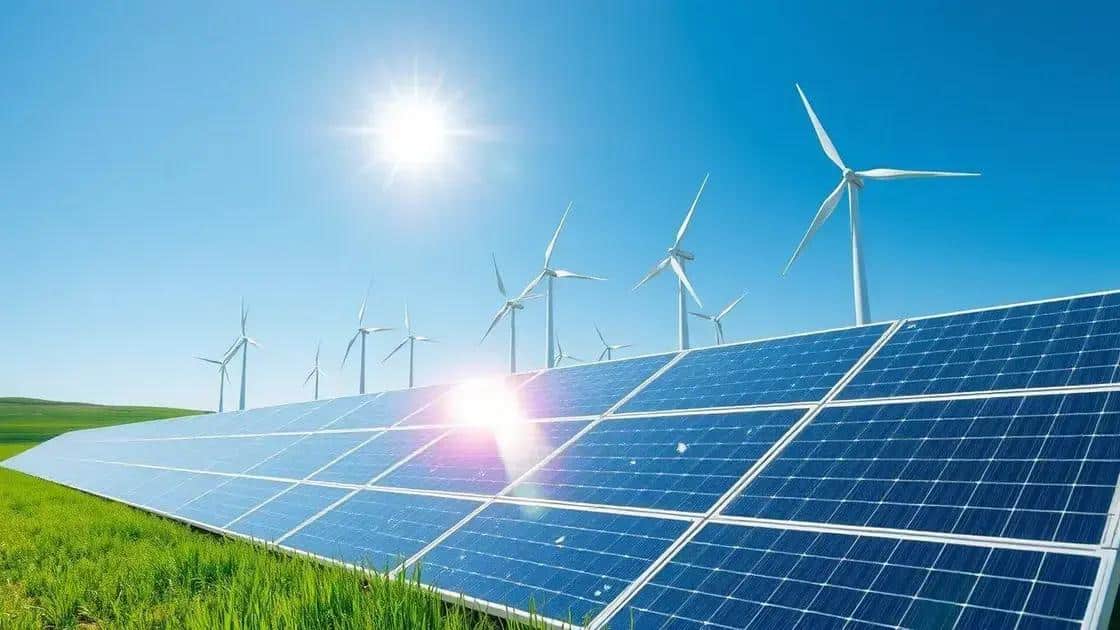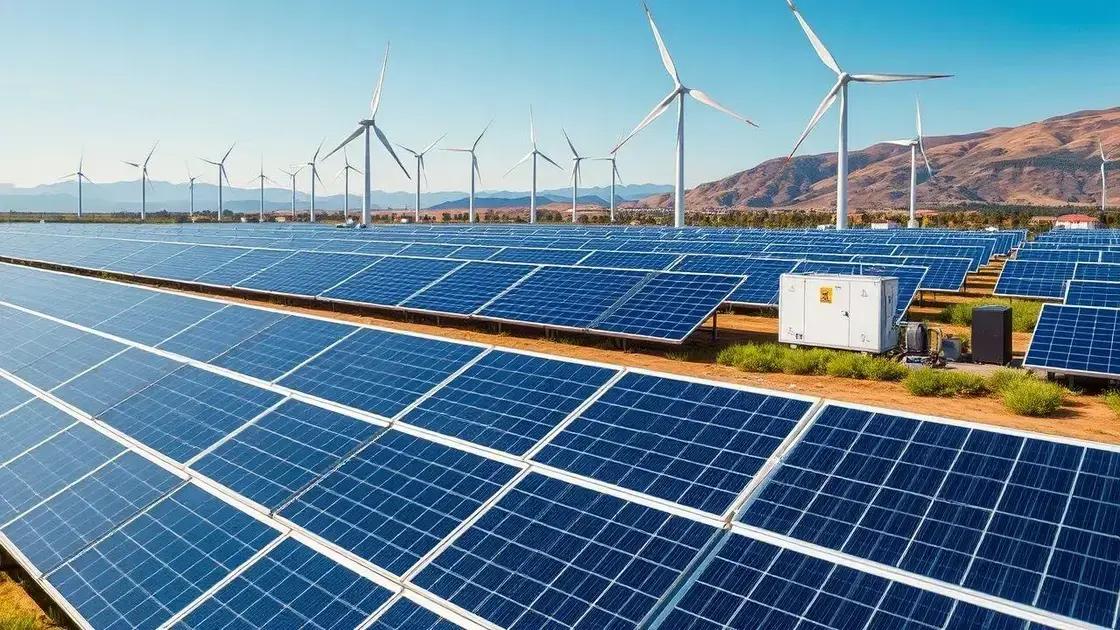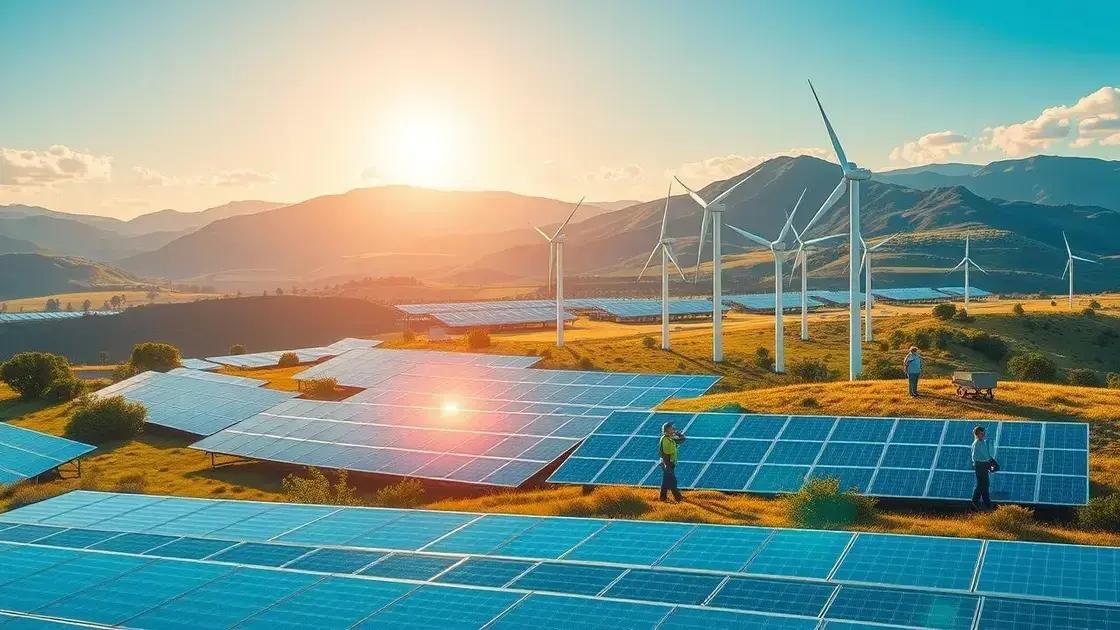Renewable energy expansion trends: what to expect next

Renewable energy expansion trends indicate significant growth driven by increased investment, technological advancements, and supportive policies aimed at overcoming challenges like intermittency and high initial costs to create a sustainable energy future.
Renewable energy expansion trends are capturing attention as the world shifts towards sustainability. Have you wondered how these trends will shape our future? Let’s dive into this evolving landscape together.
Current growth patterns in renewable energy
The push for renewable energy has led to intriguing growth patterns across various sectors. Understanding these patterns is essential for grasping the future of energy. As nations and companies prioritize sustainability, we see a shift toward cleaner options.
Global Adoption Rates
Countries around the world are increasing their use of solar, wind, and hydroelectric power. This rapid adoption is transforming energy markets. Some regions are seeing remarkable investment in renewables. Recent trends show that developing nations are also making significant strides in renewable energy sources.
- Investments in solar energy increased by over 20% in the last year.
- Wind energy capacity has doubled in the last five years.
- Hydroelectric projects are frequently receiving government support.
As countries strive toward net-zero emissions, we observe a corresponding rise in policies that favor renewable energy sources. For instance, the European Union aims to source 40% of its energy from renewables by 2030. This ambitious goal is mirrored in regions like Asia, where growth in renewable capacities has been astounding.
Technological Innovations
New technologies are also propelling these growth patterns. Innovations in battery storage and efficiency for solar panels are enabling greater energy capture and retention. As these technologies improve, the adoption of renewable energy becomes more feasible for all. These advancements not only enhance energy supply but can reduce costs for consumers.
- Advancements in photovoltaic cells increase solar panel efficiency.
- Battery technology has made storing renewable energy more efficient.
- Smart grids are optimizing energy distribution.
Furthermore, collaboration among governments, businesses, and research institutions is sparking further growth. By working together, stakeholders are developing solutions that address existing challenges in the renewable sector. This collaborative effort ensures that renewable energy continues to thrive.
Key technologies driving expansion

Several key technologies are driving the expansion of renewable energy. These advancements make it easier to harness energy from natural resources. With these technologies, communities can reduce their reliance on fossil fuels and lower greenhouse gas emissions.
Solar Power Innovations
Solar energy continues to lead the charge in renewable technologies. Innovative photovoltaic cells are making solar panels more efficient. These improvements allow for increased energy capture even in low-light conditions. As a result, more homes and businesses are adopting solar technology.
- New materials are enhancing the efficiency of solar panels.
- Flexible solar panels allow for easier installation on varied surfaces.
- Energy storage systems are improving the usability of solar energy.
Moreover, the development of solar farms is providing large-scale energy solutions. These farms use extensive arrays of solar panels to generate electricity for thousands of homes. With falling costs and improved efficiency, solar energy is becoming a pivotal part of the energy mix.
Wind Energy Breakthroughs
Wind energy technology is also experiencing rapid growth. Larger and more efficient wind turbines are creating higher energy output. Offshore wind farms are particularly promising, capturing stronger and more consistent winds. This trend is critical, especially in coastal areas, contributing significantly to local energy needs.
- Utilization of advanced materials enhances turbine durability.
- Vertical-axis turbines are gaining popularity for urban settings.
- Smart grid integration allows better energy distribution from wind power.
In addition, vertical-axis turbines are becoming popular. These are particularly useful in urban areas where space is limited. With continued innovation, the accessibility of wind energy is set to increase.
Energy Storage Solutions
Energy storage is a vital component of the renewable energy future. Advances in battery technology are allowing for better storage of solar and wind energy. These technologies enable a more reliable and consistent supply of energy, overcoming one of the major challenges in renewable adoption.
- Lithium-ion batteries are becoming more affordable and efficient.
- Grid-scale storage systems are supporting energy distribution.
- Emerging technologies like solid-state batteries promise further advancements.
As energy storage technologies evolve, they play a crucial role in balancing supply and demand. This ensures that energy generated from renewable sources can be used when needed, making renewables more practical for everyday use.
Challenges faced by the renewable energy sector
The renewable energy sector faces numerous challenges that can hinder growth. Understanding these obstacles is crucial for developing effective solutions. Various factors contribute to these challenges, each requiring attention to ensure the sustainable advancement of renewable sources.
Intermittency of Energy Sources
One of the primary issues is the intermittency of energy sources like solar and wind. These forms of energy depend on weather conditions, leading to fluctuations in power generation. This inconsistency poses a problem for grid reliability and energy planning.
- Constant fluctuations can disrupt energy supply.
- Storage solutions are needed to manage energy availability.
- Grid infrastructure must adapt to handle variable inputs.
As renewable sources become a larger part of the energy mix, addressing intermittency will be critical. Innovative solutions such as better energy storage systems and smart grid technology are essential for managing these challenges.
High Initial Costs
Another significant challenge is the cost of renewable energy technologies. Although prices for solar panels and wind turbines have decreased, the initial investment can still be high. This poses a barrier for both consumers and businesses looking to transition to renewable sources.
- Financing options need to be more accessible.
- Government incentives can help offset costs.
- Long-term savings can outweigh initial investments.
Furthermore, policymakers must work on effective strategies to make renewable technologies more affordable. By lowering the entry barriers, more individuals and businesses can participate in the energy transition.
Regulatory and Policy Barriers
Regulatory and policy challenges also play a key role in the growth of the renewable energy sector. Inconsistent regulations can create uncertainty for investors and developers. Each region may have different rules, making it difficult to standardize practices across borders.
- Streamlined policies can promote investment.
- International cooperation can enhance regulatory frameworks.
- Clear long-term energy plans will encourage development.
Policymakers must collaborate to create stable regulatory environments that promote the growth of renewable energy. Ensuring that regulations encourage rather than hinder the adoption of new technologies is vital for future progress.
Future outlook for renewable energy initiatives

The future outlook for renewable energy initiatives is promising as more countries commit to reducing carbon emissions. With advancements in technology and increasing public awareness, the focus on sustainability continues to grow. This momentum indicates a significant shift in how energy will be produced and consumed in the coming years.
Increased Investment
Investments in renewable energy are expected to rise dramatically. Governments and private sectors are recognizing the importance of transitioning to cleaner energy sources. This trend will lead to more research and development, enhancing the efficiency of renewable technologies.
- Venture capital is increasingly flowing into green startups.
- Government subsidies are incentivizing renewable projects.
- International partnerships are forming to boost investments.
As financial support increases, we can anticipate breakthroughs in renewable energy solutions. These investments may also support job creation in new, sustainable industries.
Technological Innovations
The continued evolution of technology in the renewable sector is vital for future growth. Innovations such as advanced energy storage and improved grid systems are on the horizon. These technologies will help manage energy supply and ensure consistent access to renewable sources.
- Smart grids will enhance energy distribution.
- Battery technology will make energy storage more efficient.
- Artificial intelligence will optimize energy management.
With ongoing advancements, renewable technologies will become more reliable and integrated into everyday life, making sustainable energy more accessible for everyone.
Policy and Regulatory Support
Policy decisions will play a crucial role in shaping the future of renewable energy. Supportive regulations will encourage investment and innovation in the sector. Governments must commit to strong policies that favor renewable initiatives, ensuring that sustainability remains a priority.
- Long-term energy plans will provide stability for investors.
- Clear regulations will simplify the permitting process.
- Incentives can stimulate renewable energy adoption.
By fostering an environment conducive to growth, policymakers can help accelerate the transition towards a cleaner energy future.
In conclusion, the future of renewable energy holds great promise due to increasing investments, technological innovations, and supportive policies. As we navigate challenges, collaboration among governments, businesses, and communities will be essential. With a unified effort, we can create a sustainable energy landscape that benefits everyone. Together, we can pave the way for a cleaner and greener tomorrow.
FAQ – Frequently Asked Questions about Renewable Energy Initiatives
What are the main benefits of renewable energy?
Renewable energy offers many benefits, including reduced greenhouse gas emissions, decreased reliance on fossil fuels, and the creation of new jobs in green technologies.
How does technology impact the future of renewable energy?
Technological advancements, such as improved energy storage and smart grids, enhance the efficiency and reliability of renewable energy, making it more accessible.
What challenges does the renewable energy sector face?
The sector faces challenges like intermittency of energy sources, high initial costs, and regulatory barriers that can hinder adoption and growth.
How can policies support renewable energy initiatives?
Supportive policies can create stability for investments and promote the use of renewable energy through incentives, clear regulations, and long-term planning.





